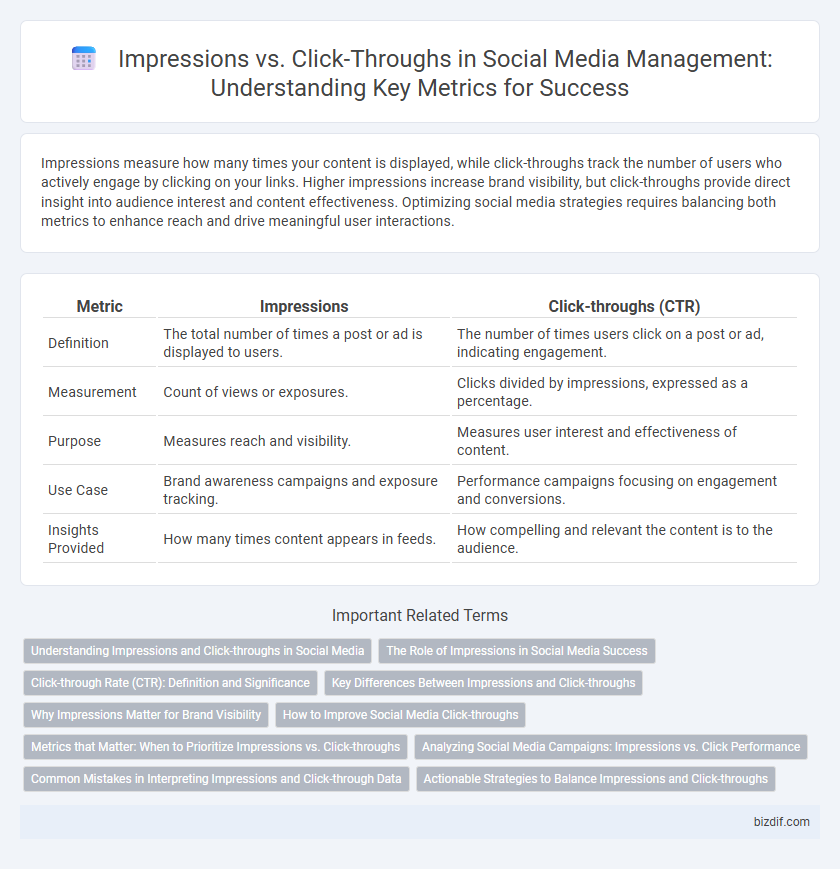Impressions measure how many times your content is displayed, while click-throughs track the number of users who actively engage by clicking on your links. Higher impressions increase brand visibility, but click-throughs provide direct insight into audience interest and content effectiveness. Optimizing social media strategies requires balancing both metrics to enhance reach and drive meaningful user interactions.
Table of Comparison
| Metric | Impressions | Click-throughs (CTR) |
|---|---|---|
| Definition | The total number of times a post or ad is displayed to users. | The number of times users click on a post or ad, indicating engagement. |
| Measurement | Count of views or exposures. | Clicks divided by impressions, expressed as a percentage. |
| Purpose | Measures reach and visibility. | Measures user interest and effectiveness of content. |
| Use Case | Brand awareness campaigns and exposure tracking. | Performance campaigns focusing on engagement and conversions. |
| Insights Provided | How many times content appears in feeds. | How compelling and relevant the content is to the audience. |
Understanding Impressions and Click-throughs in Social Media
Impressions represent the total number of times a social media post is displayed, indicating reach and visibility, while click-throughs measure how many users interacted with the post by clicking on a link or call-to-action. Tracking impressions helps evaluate brand awareness and content distribution, whereas analyzing click-through rates (CTR) provides insights into audience engagement and the effectiveness of marketing strategies. Understanding the balance between impressions and click-throughs enables social media managers to optimize campaigns for both visibility and user interaction.
The Role of Impressions in Social Media Success
Impressions serve as a crucial metric in social media management by indicating how often content is displayed to users, reflecting brand visibility and reach. High impression counts enhance the potential audience pool, increasing awareness and setting the foundation for engagement. Effective social media strategies leverage impression data to optimize posting times, content relevance, and targeting, ultimately driving better click-through rates and campaign performance.
Click-through Rate (CTR): Definition and Significance
Click-through Rate (CTR) measures the percentage of users who click on a social media post or ad after viewing it, calculated by dividing clicks by impressions and multiplying by 100. CTR is a critical metric for assessing the effectiveness of content in driving user engagement and traffic to websites or landing pages. Higher CTR indicates compelling content and targeted campaigns, directly influencing conversion rates and return on investment (ROI) in social media management.
Key Differences Between Impressions and Click-throughs
Impressions measure the total number of times a social media post or ad is displayed to users, reflecting reach and visibility, whereas click-throughs count the actual interactions when users click on the content link. Impressions indicate potential audience exposure, while click-throughs demonstrate engagement and user interest, making click-through rate (CTR) a crucial metric for assessing campaign effectiveness. Understanding these differences helps optimize strategies by balancing brand awareness with actionable user responses in social media management.
Why Impressions Matter for Brand Visibility
Impressions represent the total number of times your content is displayed, significantly boosting brand visibility by increasing audience exposure across various social media platforms. High impression counts enhance brand recognition, making potential customers more likely to remember and engage with your brand in the future. Monitoring impressions allows marketers to assess the reach of their campaigns and optimize strategies to maximize visibility and long-term engagement.
How to Improve Social Media Click-throughs
Improving social media click-throughs requires optimizing content with clear, compelling calls-to-action and engaging visuals that capture audience attention. Utilizing A/B testing for headlines, captions, and images helps identify what resonates best, increasing the likelihood of clicks. Targeting the right demographics through platform-specific analytics ensures content reaches users most interested in your offerings, boosting overall click-through rates.
Metrics that Matter: When to Prioritize Impressions vs. Click-throughs
Impressions measure how often content appears on users' screens, indicating brand visibility, while click-throughs reflect user engagement by tracking actual interactions with links. Prioritize impressions when building brand awareness and expanding reach, as high impression counts boost potential audience size. Focus on click-throughs for campaign effectiveness, conversion tracking, and driving targeted traffic to maximize return on investment in social media marketing.
Analyzing Social Media Campaigns: Impressions vs. Click Performance
Impressions measure how often your social media content is displayed, reflecting overall visibility, while click-throughs reveal user engagement by tracking the number of clicks on links within your posts. Analyzing the ratio of click-throughs to impressions, known as the click-through rate (CTR), helps determine the effectiveness of your campaign's call-to-action and audience targeting. Optimizing social media campaigns involves balancing high impressions with strong click performance to achieve meaningful user interaction and conversion goals.
Common Mistakes in Interpreting Impressions and Click-through Data
Misinterpreting impressions as direct indicators of success overlooks the importance of actual user engagement metrics like click-through rates, which reveal the effectiveness of content in driving action. Many marketers equate high impressions with high performance, ignoring that a large audience reach without clicks can signal weak call-to-action or irrelevant targeting. Overemphasis on impressions instead of click-through data leads to misguided strategies that fail to optimize conversion and audience interaction.
Actionable Strategies to Balance Impressions and Click-throughs
Maximizing social media success requires balancing high impressions with strong click-through rates by targeting a relevant audience and crafting compelling call-to-actions (CTAs). Utilizing A/B testing for content formats and posting times enhances engagement metrics, helping identify what drives both visibility and user actions. Integrating insightful analytics tools allows ongoing optimization, ensuring campaigns maintain a strategic equilibrium between broad reach and meaningful interactions.
Impressions vs Click-throughs Infographic

 bizdif.com
bizdif.com